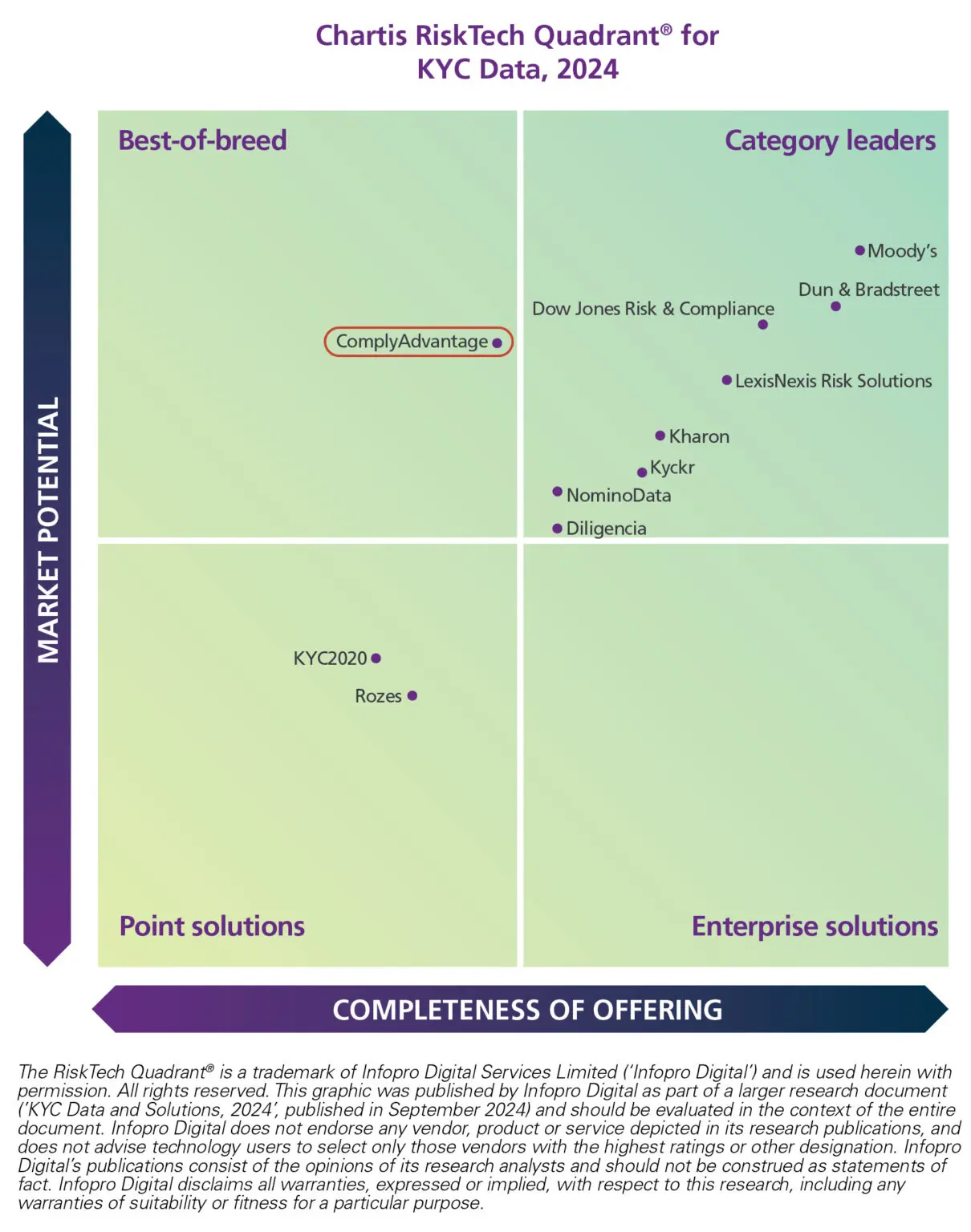
The Challenge of PEPs
A comprehensive and practical look at the PEP landscape and how firms should navigate it.
Download nowWhile regulated financial institutions are all required to have some form of politically exposed person (PEP) screening software, finding a solution that aligns with a business’ specific needs, risk profile, and diverse customer base can be daunting. Senior decision-makers must ensure their chosen software meets current demands and can scale with the organization. Despite each business’ unique challenges, the core attributes of effective PEP screening software remain consistent, with accurate and comprehensive data at the forefront.
This article presents five key tips for firms when selecting the best AML PEP screening software for their business.
Maintaining the accuracy and reliability of PEP screening processes hinges on the regular maintenance and updating of the database. This process not only involves the addition of new PEPs but also the timely removal of individuals who are deceased or no longer hold positions of public trust.
The best vendors can be differentiated from standard PEP screening solutions in this way, as they will keep track of national-level political events such as elections, cabinet appointments, reshuffles, and other significant changes. Once new PEPs are identified, their database should be updated promptly, ideally within 24 hours, to ensure the screening solution reflects the most current information.
Without up-to-date data, firms can face several significant PEP challenges and risks:
When choosing PEP screening software, firms should consider if the vendor’s software can provide access to a wide-ranging dataset that includes PEP information from all the countries relevant to the organization’s operations. Extensive coverage is essential for identifying PEPs across various jurisdictions, which helps mitigate risks associated with financial crimes.
For example, poor data coverage might mean the software only includes PEP information from a limited number of countries, missing crucial jurisdictions where the organization operates. This can lead to significant compliance gaps and an increased risk of undetected financial crimes. On the other hand, good PEP data coverage looks like:
In fact, RegTech Solutions (formerly SQA Consulting) has rated ComplyAdvantage’s PEP data coverage as ‘Excellent.’
“Our benchmarking shows ComplyAdvantage’s name-matching efficiency and effectiveness are market-leading, with name-matching rates of close to 100%. This is very good, almost exceptionally good, a little higher than we often see for exact name tests.”
RegTech Solutions
Leading AML vendors will implement a series of built-in quality checks to ensure the data is comprehensive and reliable and provides the best risk insights. This involves verifying data from multiple reputable sources and conducting thorough cross-references to identify and correct discrepancies.
However, human oversight is also crucial. While automated systems can efficiently handle routine tasks such as data scraping and initial screenings, human experts are necessary for complex cases where automated tools might not be able to pick up on certain nuances.
For instance, data strategists and researchers should intervene when the structure of a website changes or when PEPs can no longer be found on a page. A multi-eye review process, where multiple experts review each new data source, significantly reduces the risk of human error and ensures data integrity.

A comprehensive and practical look at the PEP landscape and how firms should navigate it.
Download nowThe effectiveness of PEP screening software depends on its alignment with the regulations and definitions of PEPs in each country in which a firm operates. These definitions can vary significantly and impact how FIs conduct their screening processes.
For instance, the United Kingdom mandates that individuals should be flagged as PEPs for at least 12 months after they cease to hold a prominent public function. Furthermore, following the Financial Conduct Authority’s (FCA) updated guidance, UK firms must treat domestic PEPs as lower risk as a legal starting point. Meanwhile, Canada imposes a longer monitoring period of five years for its domestic PEPs, reflecting a more stringent approach to risk management.
The diversity in PEP definitions extends beyond the duration of monitoring to include the scope of who qualifies as a PEP. While most countries encompass high-ranking government officials, their family members, and close associates, specific details can vary widely. Some jurisdictions, like the United States, only use the term “PEP” to refer to foreign individuals who are or have been entrusted with a prominent public function.
This variance underscores the critical importance of PEP screening software that can flexibly adapt to different regulatory frameworks. Ideally, the software should automatically update and reclassify individuals as “former PEPs” once the required monitoring period ends, ensuring compliance with local laws and facilitating accurate risk assessments.
Efficient integration enhances team productivity, reduces the risk of errors, and supports faster decision-making processes. This empowers organizations to uphold regulatory standards effectively while safeguarding against operational fatigue, ultimately saving time by eliminating the need for multiple tools or databases.
However, a comprehensive solution should also provide the ability to screen for other critical factors, such as sanctions hits and adverse media, all within the same platform. By consolidating PEP screening, sanctions screening, and adverse media checks into a single platform alongside existing integration capabilities, the best software solutions helps firms to eliminate any silos and allows compliance teams to access comprehensive insights promptly.
Digital bank Holvi experienced these benefits firsthand when it partnered with ComplyAdvantage for PEPs, sanctions, and adverse media screening. Holvi’s Head of AML & AFC Operations, Valentina Butera was particularly impressed with the integration that led to a speedy set-up:
“It was the smoothest implementation of tech that we have ever experienced. We did not experience any downtime or any interruption of business operations – not even for a second.”
Valentina Butera, Head of AML & AFC Operations at Holvi
As transactions become more intricate and regulatory requirements continue to evolve, traditional PEP screening methods that rely heavily on manual processes will be unable to keep up. Luckily, advanced solutions on the market can use the latest technology to improve the PEP screening process.
The Chartis RiskTech Quadrant for KYC Data has recognized ComplyAdvantage as the only best-of-breed KYC data provider, demonstrating our deep history of dedicated financial crime risk prevention expertise.

With PEP Screening by ComplyAdvantage, firms can benefit from:
ComplyAdvantage has helped 1000s of financial institutions automate their processes and unlock critical insights on domestic, foreign, and international PEPs. Book your free demo now to learn more.
Get a demoOriginally published 29 July 2024, updated 04 July 2025
Disclaimer: This is for general information only. The information presented does not constitute legal advice. ComplyAdvantage accepts no responsibility for any information contained herein and disclaims and excludes any liability in respect of the contents or for action taken based on this information.
Copyright © 2025 IVXS UK Limited (trading as ComplyAdvantage).